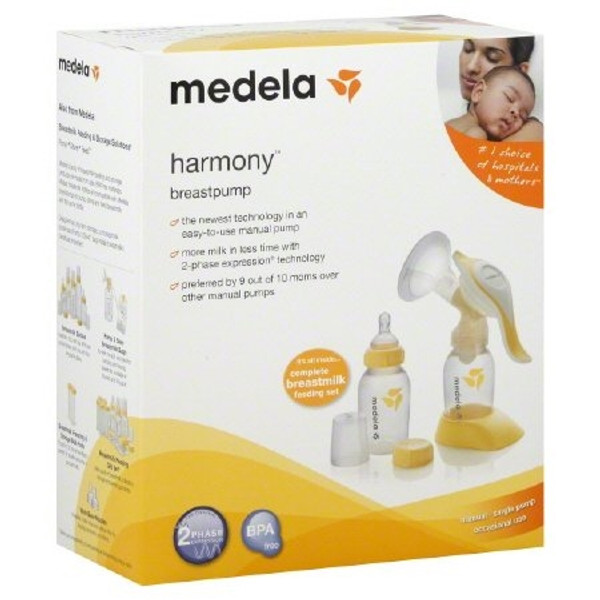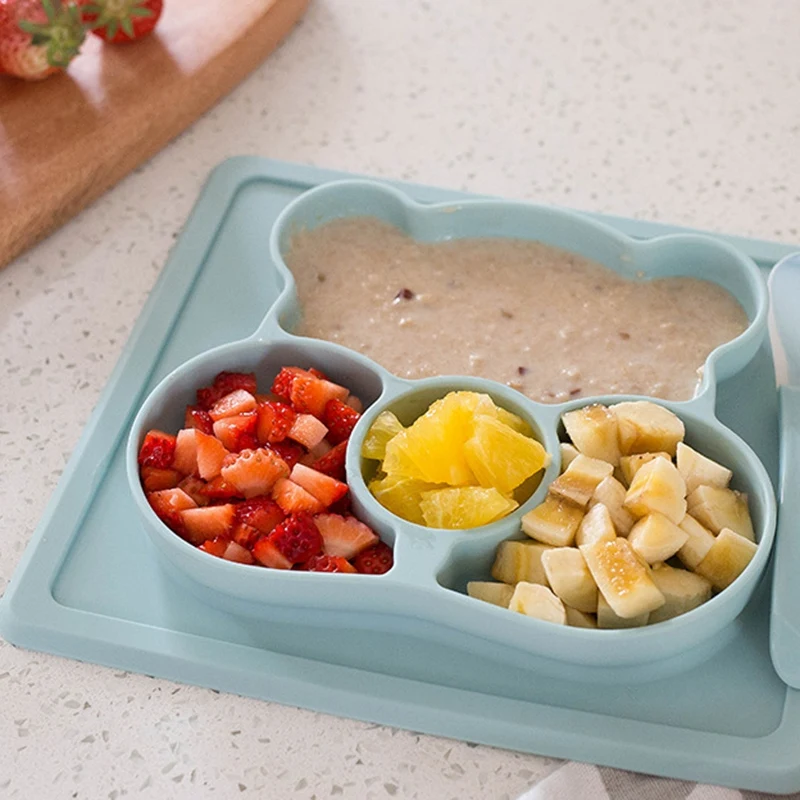Can i use breast pump to feed my baby
The pros and cons of each
Both breastfeeding and pumping are excellent ways to feed a baby breast milk. Breast milk is the natural food for infants, and pumping can offer benefits that are similar, although not identical, to providing breast milk directly from the breast.
Human breast milk is biologically designed to meet a baby’s nutritional needs, and many doctors recommend breast milk rather than feeding with formula.
Still, people should choose the feeding strategy or combination of strategies that work best for them and the infant, while taking account of the pros and cons of both breastfeeding and pumping, if necessary.
People do not have to choose exclusively between pumping and breastfeeding, as many of those who breastfeed a baby or infant decide to pump at times, as well.
Breastfeeding offers many health and cognitive benefits to babies and reduces the risks of several long-term health issues in both the woman and the baby.
Some of the benefits of feeding a baby directly from the breast include the following:
1.
Breast milk is customized food for a baby based on feedback from the baby’s body. Letting a baby feed at the breast allows its saliva to interact with the milk. This interaction sends messages to the woman’s brain about what the baby needs.
According to a 2013 study, this interaction between the breastfeeding woman and the baby ensures the baby gets the nutrients required, as well as antibodies that can protect against infections.
The breast milk has specific components if the baby is premature and changes composition as it ages. The milk also changes according to the time of day and even during a given feeding.
2. A natural feedback loop
Milk production follows a rule of supply and demand. The breasts produce more milk when the baby breastfeeds more. Allowing this natural feedback loop to control milk supply ensures that the child has enough milk but does not experience an oversupply.
Feeding a baby on demand at the breast rather than pumping to a schedule can encourage a continuing milk supply, and ensure a long and healthy feeding relationship.
3. Convenience and affordability
Breastfeeding is not free, in the strictest sense, as it requires significant labor from the woman who supplies the milk.
Exclusively feeding at the breast, however, does not impose any financial costs. Breastfeeding can save a significant amount of money, depending on the local price of formula.
Breastfeeding is also more convenient, as it requires no preparation. A baby or child can feed on the breast anywhere without the need for an adult to pack bottles, find clean water, or heat formula.
4. Easy soothing
Breastfeeding can help soothe an anxious, scared, or hurt baby.
A 2016 study found that breastfeeding a baby or infant up to 12 months old may help relieve the pain of it receiving vaccinations.
Again, feeding at the breast offers a chance to soothe the baby without the need to spend money or pack supplies.
5. Bonding time
Breastfeeding puts a woman and the baby in close skin-to-skin contact. This close contact can support bonding, help the two learn one another’s cues and personalities, and promote relaxation.
Numerous studies have shown that newborn babies have a strong physiological need to be in close contact with a caregiver. Physiological contact may even offer lifesaving benefits for newborns.
A 2014 review of accepted practice shows that skin-to-skin contact following birth can reduce the risk of hypothermia, reduce stress, and may help babies sleep. Breastfeeding a baby encourages this close contact.
Babies who feed exclusively on pumped milk do not get the benefit of a feedback loop between their body and the breast milk. However, they do still gain access to a well-designed food that is rich in healthful fats and antibodies.
The benefits of pumping milk include the following:
1. Control over timing
By pumping milk, caregivers can control the timing of feedings. They can decide on a schedule that works for them and pump when necessary based on that schedule.
They can decide on a schedule that works for them and pump when necessary based on that schedule.
Controlling the timing of feedings can facilitate a return to work and potentially free up more time.
2. Ability to share feedings
Share on PinterestPumping milk allows the caregiver to manage the baby’s feeding times.
It may be easier for people to split caregiving duties if they choose pumping over breastfeeding.
When only one person breastfeeds, that individual must handle the many feeds a baby demands, often including several nighttime wakings.
Sharing the feeding may promote a positive balance of childcare duties. The ability to share feeding may also offer some convenience and help the person who is breastfeeding feel more rested.
This ability to share feedings can be especially beneficial in the immediate postpartum period, when caregivers may be exhausted and recovering from childbirth.
If possible, parents and caregivers should not introduce a bottle until breastfeeding is well established.
3. Addressing supply issues
Pumping breast milk is one way to address breast milk supply issues. Some people choose to pump after each breastfeeding session to increase their supply. Pumping can also help build a freezer stash of milk if a person is concerned about low supply.
4. More breaks
Pumping allows the caregivers to have a break while they are coping with months, or even years, of sleep deprivation. Recovering from childbirth can be also be challenging, as can managing the time demands of caring for a baby or infant.
Pumping and storing breast milk can allow caregivers to go out for a few hours, go on a date night, or even go on vacation while still leaving behind enough food for their baby.
If a person is working then pumping their breast milk allows those who are caring for the baby to offer them the same healthful breast milk.
5. Donor milk
Biological parents are not the only people who can supply breast milk. Some babies receive breast milk from donors.
An adopted baby might receive donor milk. Similarly, a person who cannot produce enough milk might supplement their supply with milk from a milk bank. The pumped milk may be the only way for some babies to get breast milk.
The American Academy of Pediatrics emphasize that all babies should get human milk and recommend exclusive breastfeeding for 6 months. But when a woman cannot produce milk, pumped milk from a donor is a better option than formula.
There are milk banks available that ensure the milk is safe to use, as breast milk can transfer some illnesses.
Some of the challenges of breastfeeding include:
1. Less control over timing
When a baby breastfeeds, a woman must feed the baby when it is hungry. It can be more difficult to establish a regular schedule when the breast is the source of food and is always available. Breastfed babies are fed on demand, not on a schedule.
2. Sore nipples and other ailments
Many women experience sore, cracked, or even infected nipples while breastfeeding. While this can also happen with pumping, a poor latch of the baby and the intense suction of breastfeeding is more likely to cause nipple pain than pumping.
While this can also happen with pumping, a poor latch of the baby and the intense suction of breastfeeding is more likely to cause nipple pain than pumping.
3. Issues with the balance of labor
People may experience an imbalance of labor when one caregiver takes sole responsibility for feeding the baby.
Infants eat many times each day, and this can leave the person who is breastfeeding with very little time.
Pumping milk is the better choice compared to formula, but it does not offer as many health and immune system benefits.
Some drawbacks of pumping breast milk include:
1. Fewer immune system benefits
There is not a feedback loop between the baby and the breast milk when a woman exclusively pumps their milk or uses donor milk.
Pumping means the milk may not be as tailored to the baby’s needs at any one moment, and so it will potentially offer fewer benefits for the immune system.
2. Additional expense
Share on PinterestMonitoring the dates of frozen breast milk may be difficult.
Exclusively breastfeeding is free, but pumping requires equipment. Pumping equipment may include:
- breast pump
- bottles
- milk storage bags
- phalanges for the breast pump
- a hands-free pumping bra
Some people also invest in an additional refrigerator and freezer to store pumped milk.
3. Privacy and convenience concerns
Taking a breast pump on vacation, to work, or on a family outing can be inconvenient. While it is possible to discreetly breastfeed in public, expressing milk with a noisy pump can be more difficult.
Some adults find that pumping offers less privacy and is more inconvenient, especially when they exclusively pump on a regular schedule.
4. Storage concerns
Some women can express a large supply of breast milk. Breast milk expires even when frozen, and storing it can be difficult.
Finding an appropriate way to save milk and keeping track of what order to use it in can be challenging.
A woman may breastfeed a baby when they are home and pump at night to build up a supply of milk for when they are away. The only right choice is the one that works best for the individual.
Some factors to take into account when deciding to pump or breastfeed may include the following:
- The support of family, friends, and partners, and how that support, or lack of it, might make one choice easier than the other.
- Being able to maintain an ample supply of milk by breastfeeding or having pumped milk available.
- Balancing the benefits of breastfeeding with the benefits of a caregiver having time to themselves.
- Whether it is important that people other than the breastfeeding woman can feed the baby.
- Whether they are using donor milk.
- Whether they are supplementing breast milk with formula.
Both breastfeeding and giving a baby pumped breast milk offer extensive health benefits. Pumping and breastfeeding also require a significant commitment from the person providing the milk.
There is no right or wrong answer, and it is important to consider the effects of each way of feeding on both the woman and the baby.
Q:
How might my feeding strategy affect my health? What about my baby’s health?
A:
The ideal way to feed a baby is at the breast where there is an interaction between the baby and the person’s breast. Supply and demand, as well as bacteria-fighting elements in the breast milk, respond to the baby being on the breast. Pumping the breast is also a good choice, but the breast will not be able to respond to the baby directly. Breast milk is the ideal food for the first 6 months of life, and breastfeeding provides life-long benefits to the adult and baby. These benefits increase the longer a person breastfeeds. I recommend breastfeeding for at least a year for the best health benefits.
Answers represent the opinions of our medical experts. All content is strictly informational and should not be considered medical advice.
Breastfeeding FAQs: Pumping (for Parents)
Many breastfeeding moms pump their breast milk to give to their baby when they are away. Here’s some information about pumps and when and how to pump safely.
What Type of Pump Do I Need?
That really depends on how often you plan to use your pump. Manual pumps tend to be best for occasional pumping, while electric pumps are better for regular or daily pumping.
- Manual pumps. Manual (or hand-operated) pumps are small and inexpensive (less than $50) compared with electric pumps. They take more effort and more time than electric pumps to draw out milk, so they’re better for occasional use. Many women keep a manual pump as a back-up in case there’s a power outage or problem with their electric pump.
- Electric pumps. Electric (or automatic) pumps can be easier to use than manual pumps because they don't require as much physical effort and can draw out the milk faster.
 Many models let you pump both breasts at once, which is a real time-saver. This also may increase your milk supply. Electric pumps come in many sizes. Most can be plugged in or are battery-operated.
Many models let you pump both breasts at once, which is a real time-saver. This also may increase your milk supply. Electric pumps come in many sizes. Most can be plugged in or are battery-operated.
Most insurance plans will cover a breast pump. Call to find out if you can receive a free pump. If not, you can buy or rent a breast pump from lactation consultants, hospitals, retail stores, and online. If you don't have the money to buy or rent a pump, contact Women, Infants, and Children (WIC) to find out about their free or low-cost pump program and see if you qualify.
Are Used Pumps OK?
It's not a good idea to borrow or buy someone else's used pump. This is because bacteria and viruses from the previous owner can get trapped inside the pump. They are potentially hazardous to your baby's health, even with repeated sterilization and cleaning.
Hospital-grade pumps, though, are meant for more than one user. These pumps let women use their own accessory kits, which lowers the risk of contamination.
Why Would I Need to Pump Right After Birth?
If your baby can’t eat due to an early birth or illness, or if you are separated from each other, you can pump your milk. In the first 2 hours after birth, hand-express your breast and then begin pumping every 2–3 hours. Use a hospital-grade pump or an electric pump, if possible. You will make only small amounts of colostrum (a rich “pre-milk”) until your milk fully comes in. Keep pumping and your supply will slowly increase.
If your baby is exclusively breastfeeding and gaining weight as expected, there’s no need to pump right away. It can be tempting to build up a supply of milk for later. But this isn’t a good idea because it can cause an over-supply of milk and keep your breasts engorged (over-full) for a longer period of time than expected.
When Can I Begin Pumping to Build Up a Milk Supply?
If you'll return to work after maternity leave or plan to spend time away from your baby, start pumping a couple of weeks before. This will give you time to practice with the pump and get comfortable using it. It also gives your baby time to learn how to drink from a bottle.
This will give you time to practice with the pump and get comfortable using it. It also gives your baby time to learn how to drink from a bottle.
How much milk women can express with a pump varies. Don’t be discouraged if it takes a few pumping sessions for you to express enough milk for a full bottle. Some women find that they express more milk when their baby is close by, if they look at a picture of the baby, or if they smell a piece of the baby’s clothing. While it may take time to get the hang of pumping, it’s a great way to ensure that your baby continues to get breast milk even when you’re not there.
If you have questions or concerns about how much milk you are expressing, talk to a lactation consultant or your health care provider.
What Can Make Pumping Easier?
It can take a little practice and time for your body (and your mind) to get used to producing milk without your baby's help. These tips can make things easier:
- Find a comfortable spot and relax.
 Your let-down reflex (when milk is released) can be affected if you're frustrated, anxious, or rushed. So sit in a comfortable spot and try not to think about other things you need to do. Listening to soothing music can help. Find out what works best for you so that you can relax.
Your let-down reflex (when milk is released) can be affected if you're frustrated, anxious, or rushed. So sit in a comfortable spot and try not to think about other things you need to do. Listening to soothing music can help. Find out what works best for you so that you can relax. - Massage your breast before and during pumping. Using your hands to massage and compress the breast can help empty them more efficiently. This can be hard if pumping both breasts at once so consider wearing a hands-free bra.
- Hold something that reminds you of your baby, like a picture or video on your phone, or has your baby's scent, like a blanket or piece of clothing. This can help you get in the right frame of mind and trigger let-down.
- Place the breast shield (flange) correctly over your breast. The breast shield is the plastic cup that goes over the nipple and areola (the dark circle of skin around your nipple) when you pump.
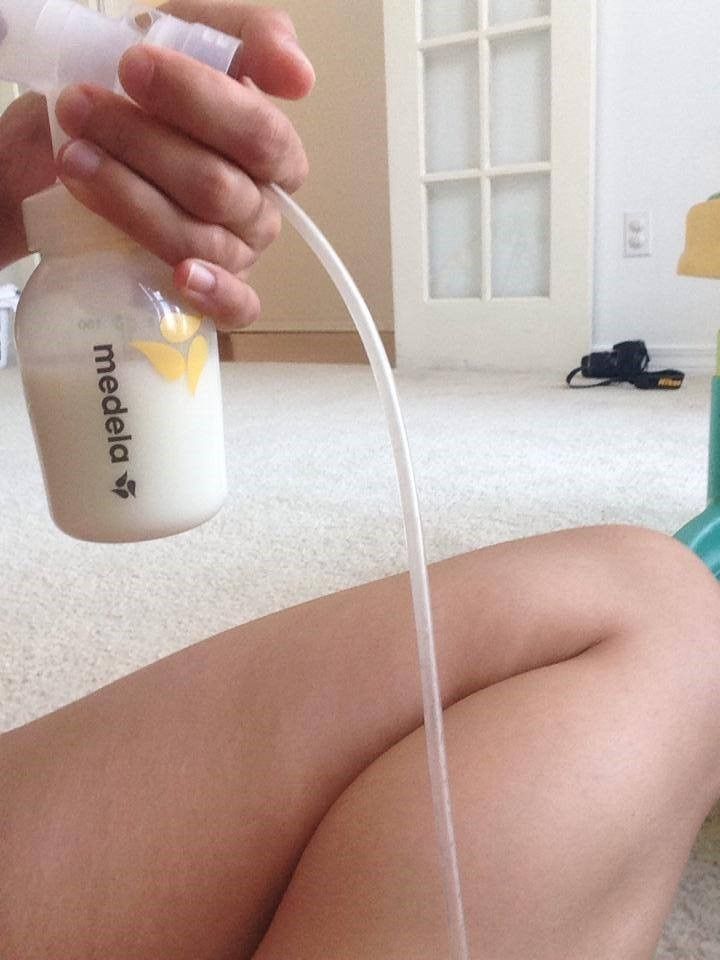 Make sure it’s covering your entire nipple and areola (not just the top of your nipple) and get a good seal. If this doesn’t happen, you may be uncomfortable and less likely to get the milk you need.
Make sure it’s covering your entire nipple and areola (not just the top of your nipple) and get a good seal. If this doesn’t happen, you may be uncomfortable and less likely to get the milk you need. - Find the right size breast shield for your breast. While pumping, your nipple should move freely inside the tunnel of the breast shield without too much of your areola being drawn in. If this is happening or pumping is uncomfortable, try a different flange size. Most pumps come with different flange sizes, so find the best fit.
- Adjust the speed and suction to the level that's comfortable for you when using an electric pump. This will help prevent any discomfort. It’s best to use the lowest setting that allows milk to flow comfortably.
Where Can I Pump at Work?
If you're pumping at work, find a discreet place where you feel comfortable.
Many companies offer their employees pumping and nursing areas. If yours doesn't, ask your supervisor or the human resources department about an office or other private area that might be suitable. Employers are required by law to provide an appropriate area (that's not a bathroom) for employees to pump breast milk and reasonable time to do so.
Employers are required by law to provide an appropriate area (that's not a bathroom) for employees to pump breast milk and reasonable time to do so.
How Do I Clean Pump Parts?
Before their first use, wash and then sterilize breast pump supplies (for example, the breast shields and any other part that touches your breasts or your milk) by boiling them for 5 to 10 minutes. Check the manufacturer's directions about how long to boil the parts.
You also can sterilize the parts with a countertop or microwaveable sterilizer, but boiling works just as well and costs nothing. After that, wash the bottles, nipples, and pump supplies in hot, soapy water (or run them through the dishwasher) after every use. They can spread bacteria if not cleaned properly.
How to use a breast pump | Tips for using your breast pump
It may take some time and patience to learn how to use a breast pump, but the results are well worth the effort. Find tips from Medela experts to help you learn how to pump with a breast pump.
Share this information
Dr Nania Schärer-Hernández, Head of Global Medical Affairs and Education, Medela:
Nania is a mother of two and the world's leading expert on lactation and breast milk composition. At Medela, she leads a team of specialists who prepare educational materials based on the latest research. The group develops guidelines for physicians and educates mothers around the world about the amazing benefits of breast milk.
As with any new business, it may take you some time to get used to using a breast pump. It's important to be patient and not get frustrated if you can't express enough milk right away. After all, a breast pump simply cannot give you the same tender feelings as a baby. However, over time, your body will get used to and learn how to trigger the flow of milk when using a breast pump, and the amount of milk you can express will increase. nine0003
1. No need to rush to start pumping
For the first four weeks, you and your baby will work together to start and build milk production. If the baby is healthy and breastfeeding is normal, you will not need to express any additional milk. Pumping, however, can be very helpful if you need to be away from your baby for a while (see tip below). Otherwise, just enjoy spending time with your baby and be sure that even if you plan to pump regularly in the future, there is absolutely no point in “training” your body by pumping milk in the first few weeks. nine0003
If the baby is healthy and breastfeeding is normal, you will not need to express any additional milk. Pumping, however, can be very helpful if you need to be away from your baby for a while (see tip below). Otherwise, just enjoy spending time with your baby and be sure that even if you plan to pump regularly in the future, there is absolutely no point in “training” your body by pumping milk in the first few weeks. nine0003
2. Cases where the baby cannot breastfeed
If your baby cannot feed directly on the breast, for example, because he was born prematurely or has special needs, or you have to be separated for some reason, start double pumping as soon as possible before.
Research has shown that starting pumping within the first few hours after birth (when a healthy baby usually breastfeeds for the first time) helps women produce more milk in the first days and weeks 1.2 and gives the child the maximum chance in the future to feed exclusively on mother's milk.
If your baby is expected to be born prematurely, need intensive care, or otherwise find it difficult to breastfeed, prepare ahead of time. Read up on pumping, stock up on equipment, and seek support from a lactation consultant or specialist.
Your maternity hospital most likely has a clinical double breast pump*, so ask them to show you how to use it. It is very important to express milk at a time when, under normal circumstances, you would breastfeed your baby. In this way, your breasts will receive a signal to continue producing milk. Try to start with 8 to 10 pumps per day 3 , and after the “arrival” of milk, continue to express with the same frequency.
3. Correct time
The first pumping must last at least 15 minutes.
Don't worry if you don't get much milk the first time. Regular use of a breast pump should stimulate your breasts and soon they will begin to produce more milk.
Some mothers are able to express the most milk an hour after feeding, while others prefer to express milk immediately after every second feeding. Try doing this at different times to see what works best for you. Once you have determined the optimal time, stick to this routine,
Try doing this at different times to see what works best for you. Once you have determined the optimal time, stick to this routine,
so that your body gets used to using a breast pump and tunes in to additional milk production. You may want to extend the intervals between pumping so that you can collect more milk later. But if you wait until your breasts are full, you won't be able to completely empty your breasts in one pumping 3.4 , so you need to express often and regularly.
4. Maintain hygiene
Always wash your hands before and after pumping, rinse all parts of the pump that come into contact with your baby's milk and mouth, and thoroughly sanitize them at least once a day. All parts of the breast pump must be completely dry before being stored in a clean bag or container until next use. nine0003
5. Prepare yourself
Prepare everything you need before pumping so you don't interrupt the process. You may want to drink or eat, you may need a phone or TV remote control, bottles or storage bags to collect your expressed milk, and a diaper in case you spill something.
The specially designed pumping top allows hands-free pumping, making it easier for you to set up your pump and do other things while you pump. nine0003
6. Get comfortable
The best position for pumping is the one you feel comfortable in
. To release the hormone oxytocin, which stimulates the flow of milk, it is very important to relax. Any discomfort or distractions can interfere with this process 5 , so choose a comfortable and quiet place to pump, and position yourself so that there is support under your back and shoulders.
If you are not wearing a pumping bustier top, hold the breast pump funnel between your thumb and forefinger and use your other fingers and palm to support your breasts. Carefully apply the funnel to the breast, do not apply too much pressure, as this can lead to compression of the breast tissue and make it difficult for milk to flow. nine0003
Some women benefit from deep breathing, soothing music, visualization of pleasant images, or relaxing back and shoulder massages from their partner.
7. Start a rush of milk
Most Medela* electronic and battery-powered breast pumps feature 2-Phase Expression technology, which mimics a baby's natural sucking rhythm (when quick and light sucking movements are followed by slower and more intense ones) to help trigger the rush milk. Breast massage before and during pumping 6 Warming the breasts 7 with a warm compress (such as a flannel) before pumping also promotes milk flow and increases the amount received.
Researchers have found that skin-to-skin contact with a baby before and during pumping can also increase milk production 8 . This is due to the fact that the warmth and touch of the baby triggers the production of oxytocin in your body 9 . Some moms even find that pumping is best when
Feed your baby on one breast and pump from the other at the same time, as this creates additional stimulation.
If your baby is not with you, try looking at a picture or video of the baby while pumping, or smelling his clothes 10 . Any opportunity to connect with the baby during the pumping process also helps to increase the level of oxytocin and, accordingly, a better milk flow.
Any opportunity to connect with the baby during the pumping process also helps to increase the level of oxytocin and, accordingly, a better milk flow.
8. Take advantage of the rush
Many mothers don't feel the rush, so keep an eye on it while pumping. When milk trickles into the bottle or bag, this means that the rush has begun 11 .
If you are using a 2-Phase Expression technology breast pump, it will have a stimulation mode and a pumping mode. Normally, stimulation mode lasts about two minutes, but as soon as you notice trickles of milk, as described above, you will need to switch to pumping mode. The first flush usually produces about 36% of the total milk volume, so it must be used to collect more milk 12 .
9. Find the most comfortable level
During the pumping phase, set the vacuum to the highest comfort level, the highest level setting on the breast pump that allows you to pump comfortably. Studies have shown that you can collect almost the same amount of milk as if you were breastfeeding your baby 13. 14 .
14 .
To find the right level for you, increase the vacuum gradually until you feel slightly uncomfortable, and then lower it by one notch. nine0003
10. Decide how long to pump
Once your milk supply is established (after about 4-6 weeks), it will be easier for you to determine how many minutes to pump. This will save time. For some women, pumping takes longer, which is related to the number of hot flashes - it is they who determine how often and for how long milk is produced 4.15 . Surprisingly, each mother has her own unique “mode” of milk flow, while it remains the same during pumping and breastfeeding 16 .
How do you define your own mode? Pick a time when you usually express the most milk and watch your pumping, noticing when the milk starts to trickle out of the nipple or when the milk starts to drain into the container.
Women who only have flushes at the start of pumping will be able to express most of their milk within 8 to 10 minutes, and increasing the duration of pumping will have no effect on how much milk they get. In contrast, women who experience multiple flushes or who have hot flashes later on may take 15 minutes or more to completely empty their breasts 15 .
In contrast, women who experience multiple flushes or who have hot flashes later on may take 15 minutes or more to completely empty their breasts 15 .
11. Choose double pumping
If you plan to express milk regularly, it makes sense to purchase a double breast pump. Double pumping increases the level of prolactin, the hormone responsible for milk production 17 . Surprisingly, studies have shown that women who practice double pumping experience an extra boost of milk with each pumping session. This means that they express almost 1/5 more milk and this milk has a higher fat content compared to consecutive pumping from each breast 18 . In addition to saving time, this creates a tangible benefit: You can get an extra bottle of milk in just a few sessions.
12. Don't be uncomfortable
Expressing breastmilk doesn't have to be painful. If you experience discomfort when pumping, or if your nipples or breasts are blistered or chafed, try changing the pump mode.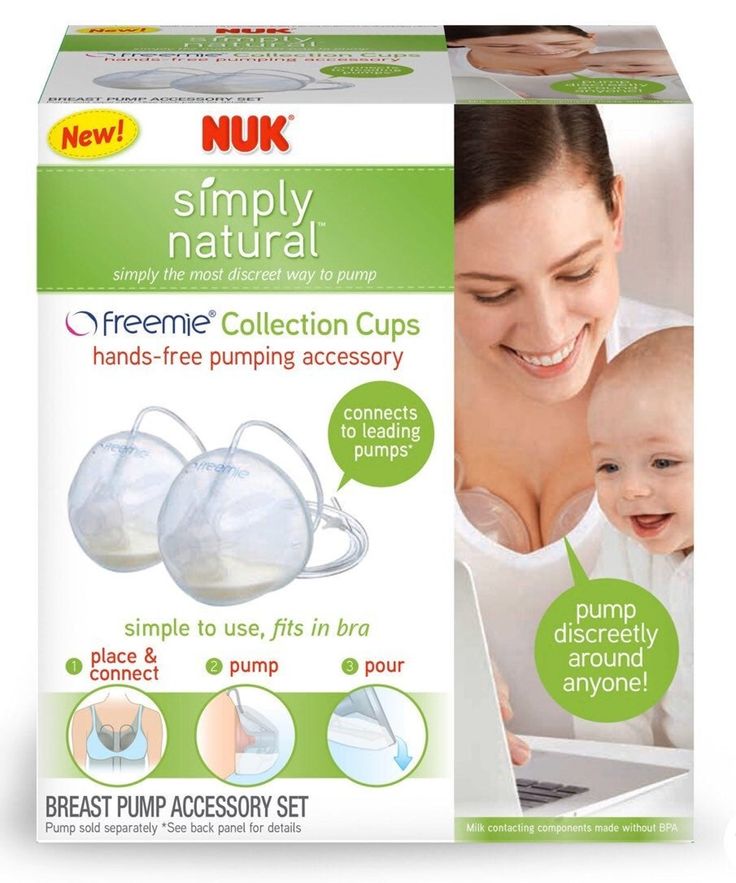
Also check the size of the funnel (the bell-shaped part of the breast pump that fits against the breast). The funnel tunnel should fit snugly against the nipple, but leave enough room for the nipple to move freely back and forth without friction. During pumping, the tunnel should not rub against the skin or draw in too much of the areola (the dark area around the nipple) or breast skin around it. A funnel that does not fit well on the breast can result in reduced milk output, which is why Medela manufactures different sizes of breast shields. nine0153 premature infants 9015 3 9015) FASEB Journal. 2017; 31(1 Supplement): 650–19 (Journal FASEB. 2017; 31 (Appendix 1): 650–19).
 K. et al. (Prime DK et al.) Dynamics of milk removal during simultaneous breast expression in women . Breastf Med. (Breastfeeding Medicine) 2012; 7(2): 100–6.
K. et al. (Prime DK et al.) Dynamics of milk removal during simultaneous breast expression in women . Breastf Med. (Breastfeeding Medicine) 2012; 7(2): 100–6. 
 Adv Neonatal Care. (Advances in Neonatal Care) 2012; 12(2): 112– breast milk J Obstet Gynecol Neonatal Nurs. 2) 41(1): 114–21.
Adv Neonatal Care. (Advances in Neonatal Care) 2012; 12(2): 112– breast milk J Obstet Gynecol Neonatal Nurs. 2) 41(1): 114–21.  Breastfeed Med. (Breastfeeding Medicine) 2012; 7(6): 442–7. nine0134
Breastfeed Med. (Breastfeeding Medicine) 2012; 7(6): 442–7. nine0134 Read instructions before use. Consult a specialist about possible contraindications.
*RU No. FZZ 2010/06525 dated 03/17/2021
Pumping when mom needs to go away | Philips Avent
Search Support IconSearch Keywords
Home ›› Weaning Mom
Home ›› Weaning Mom
↑ Top
Even if you can't be near your baby, you can be sure that by pumping, he will receive all the necessary nutrients from breast milk. Perhaps you are already using a breast pump to continue breastfeeding when you go to work, or you just want to have more free time between feedings.
3 Philips Avent products to help you pump and store milk comfortably:
Not sure when to start expressing milk or when to start using a breast pump? Don't worry, we've put together a quick guide to help you learn how to express milk and learn about the benefits of using a breast pump. We'll also give you tips on how to express your milk when you're away from home, how to keep it adequate, and how to store it safely.
We'll also give you tips on how to express your milk when you're away from home, how to keep it adequate, and how to store it safely.
When should I start expressing milk? nine0008
Most women begin to express milk after six months, but there are circumstances that force them to do so sooner.
If you intend to express milk as early as possible, the answer to the question “When can I start expressing milk?” will be: "A few hours after birth." Some mothers find that expressing milk is effective at a very early stage, especially if the baby has latch-on problems, as pumping improves the flow of milk to the breast. nine0009
Other mothers start expressing milk after breastfeeding is established because they want someone in the household to help with feeds while they are away or with feeds after they go to work.
There are no specific rules about when to start pumping, so you can do whatever works best for you. Whatever your needs, you can pump to make your schedule less dependent on feedings.
How to express breast milk: general questions
How long should I express milk? How much milk do I need to express? What equipment do I need for this? Every mother has questions about this topic, however, once she starts expressing milk, she easily adapts to this process.
Most moms find a breast pump to be the easiest way to express breast milk. The principle of operation of different breast pumps may vary slightly, so read the instructions for use before using the device. Remember that it can take 1-2 minutes for milk to come out of your breast during pumping, so don't worry if you don't see it right away! nine0003
Not sure how long to express milk? If you are not in a hurry, try to express milk until you feel that your chest is empty. Due to the individual characteristics of each woman, the pumping time will be different.
The amount of milk expressed will depend on when you last breastfed and how long you have been using the pump and are accustomed to using it. Even your internal state and time of day can affect the amount of milk. If you have problems with lactation, check out our tips for increasing your milk supply. Generally, the best time to express is in the morning. During sleep, there is an increase in the level of hormones responsible for the production of milk. nine0003
Even your internal state and time of day can affect the amount of milk. If you have problems with lactation, check out our tips for increasing your milk supply. Generally, the best time to express is in the morning. During sleep, there is an increase in the level of hormones responsible for the production of milk. nine0003
Should breastfeeding be combined with pumping? Wait about an hour between pumping and the next feeding. So you will be sure that the baby will have enough milk! Feed your baby as much as it takes to keep him full and happy. Use a breast pump to fully express milk from your breasts and save excess milk.
How to Express Breast Milk: Practical Tips
Whether you are expressing milk at home (for a night feed) or at work, there are a few key things to keep in mind to help you. nine0003
1. Plan ahead. If you have to leave your baby, start using a breast pump a few weeks in advance. This way you will store enough milk for your baby and get used to using a breast pump.
2. Be ready. You may be aware of the so-called "oxytocin reflex", which stimulates the flow of milk due to the release of the hormone oxytocin. Oxytocin increases the secretion of breast milk that can be expressed. The production of the hormone can be caused in many ways, even just by looking at the child. Therefore, many mothers find it effective to look at a photo of their baby while pumping while away from home. After you finish pumping, you can also use bra pads to keep your breasts dry and protect your clothes from milk stains. nine0009
3.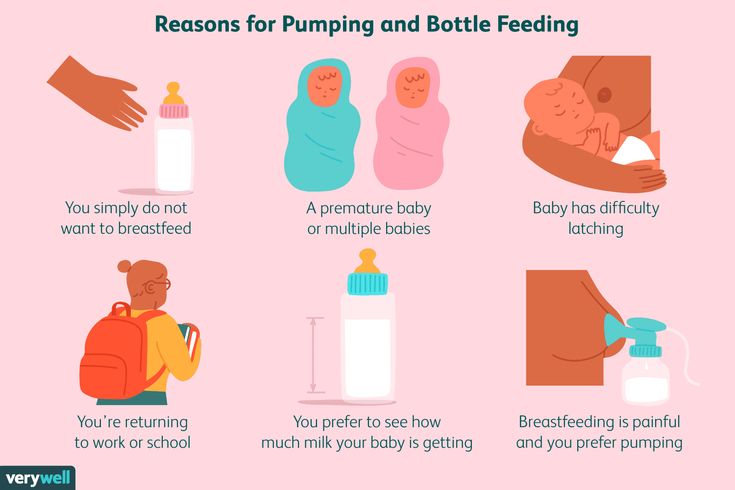 Get comfortable. The more comfortable you feel, the easier it will be to express milk. Find a quiet, private place and feel free to change the lighting and music to your liking. It is helpful to find a seat with good support so that you can sit comfortably with the pump in front of you.
Get comfortable. The more comfortable you feel, the easier it will be to express milk. Find a quiet, private place and feel free to change the lighting and music to your liking. It is helpful to find a seat with good support so that you can sit comfortably with the pump in front of you.
4. Express as many times as you would like to breastfeed your baby. To maintain the required supply of milk, express it as often as you normally feed your baby. Thus, if the baby usually has three feedings during your absence, then you need to express milk at least three times. nine0003
How to choose the best pump for expressing milk
There are several different types of breast pumps, each with its own advantages. Choose the one that will help you feel comfortable in your daily life. Perhaps you prefer to have a device that is designed to be used on the go? Or do you need a breast pump that will allow you to express milk quickly?
Storage and preparation of milk after pumping
After you have expressed your milk, remember to freeze it or refrigerate it.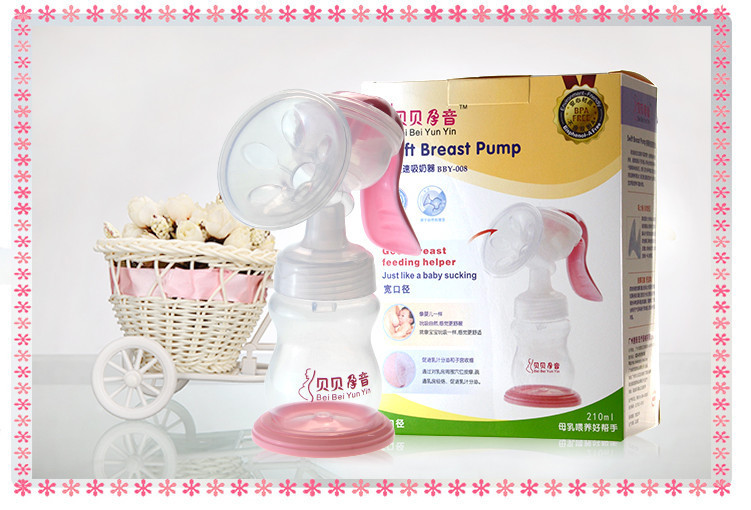 Then, before feeding the baby, it must be thawed and warmed up. Here are some tips on how to store breast milk:
Then, before feeding the baby, it must be thawed and warmed up. Here are some tips on how to store breast milk:
- Use sterile milk storage containers or freezer bags to collect and store milk.
- Do not fill the container to the upper limit, because. when frozen, breast milk "expands", the optimal portion for storage is 60-120 ml. nine0247
- Label the container with the pumping date or write the pumping date on the container with a permanent marker.
- Store milk in the refrigerator at 2-4°C for up to 24 hours.
- After cooling the expressed milk in the refrigerator for 0.5 hours, the milk can be frozen in the freezer and stored there for 3 months.
- Place the milk closer to the back of the refrigerator or freezer rather than in the door to keep the milk at a constant temperature. nine0247
- Thawed milk placed in the refrigerator should be used within 24 hours.
- Do not refreeze defrosted milk.
- Transport milk in an insulated container with an ice pack.

Use these tips to prepare your expressed milk for breastfeeding:
- Thaw or warm breast milk under running warm water, in a bain-marie, or with a bottle warmer. nine0247
- Do not use a microwave oven to heat milk.
- Do not heat milk to boiling point.
- Shake the milk bottle before feeding until smooth.
- Check milk temperature before feeding. The most optimal temperature is the average between body temperature and room temperature. To check the temperature of milk, you can drop it on your skin.
Advice for first-time moms
If you are just starting to express milk, remember that this process may not be entirely comfortable. The more relaxed you are, the easier it will be to express milk. Sometimes this will be difficult to do, for example if you are trying to express milk during a busy work day or in an unfamiliar place; therefore, it is necessary to practice well at home and show patience.